Well, isn’t it about time? I finally have a full-fledged embroidery project underway, and I can’t wait to share updates, tips, techniques, mistakes, divergences, and so forth with you again. I always have Much More Fun with my embroidery when I journey through a project with you!
Let’s talk about ground fabric, shall we? Besides coming up with the embroidery design and a general idea of colors and threads, ground fabric is my First Big Consideration when starting a project.
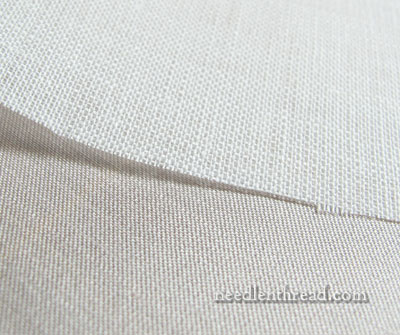
I’m calling this project Mission Rose. It’s a rose (this rose, as a matter of fact, with some variation in the setting and design), and the Mission part comes from the style of the design, which reminds me of something a little Arts-and-Crafts-ish, and a little Mission furniture-ish. So, Mission Rose it is!
If you’ve been sticking around with me on Needle ‘n Thread for a while, you probably expect that the ground fabric is going to be linen. After all, I am a Linen Fanatic, right? And I can’t think of any major project I’ve done on the website that hasn’t been on linen – can you?
But… guess what? I’m Not Using Linen for the Ground Fabric! I decided to leap outside the confines of my obsession with linen, and go for a silk ground. A couple years ago, a close friend went silk shopping for me while he was in Japan, and he bought me some yardage of some beautiful silks. I decided it’s time to use them!
The actual ground fabric for the project is the fabric in the lower portion of the photo above. It is a beautiful silk in a blush-pink. It’s hard to explain, and the picture doesn’t quite do it justice!
And in addition to the pink, I’m using some blue in the piece, which will be appliquéd to the pink ground fabric.
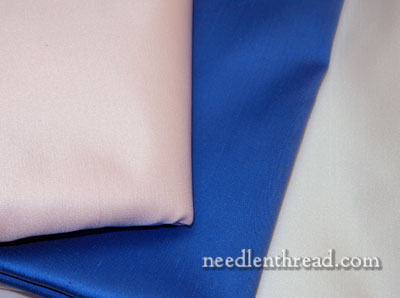
You can get a better idea of the pink in the photo above, but the blue is a little off this time – it looks awfully dark and bright.
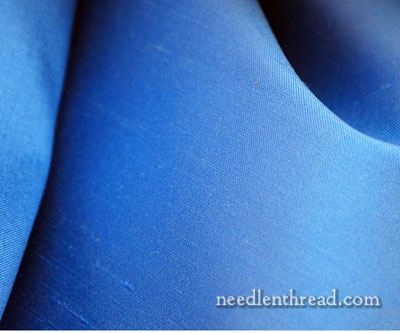
In the photo above, if you take the “medium” color of blue there – not the lightest, not the darkest – you might get a better idea of the blue silk.
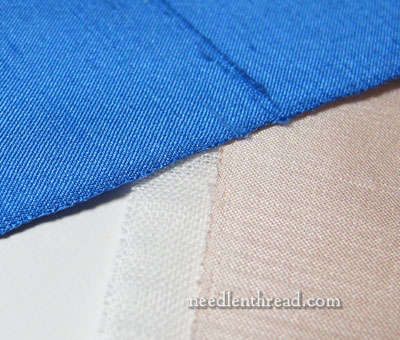
Here we see the three fabrics I’ll be using together.
Backing Fabric for Embroidery Projects
Backing the pink silk will be a piece of fine linen. A backing fabric provides support for finer fabrics, especially when working heavy embroidery or goldwork on the ground fabric. For this design, the embroidery won’t necessarily be heavy, but since I’ll be using gold threads, I definitely wanted a backing fabric behind the ground.
I chose linen over muslin because this particular linen (which is bright white Legacy linen used for shadow work – it’s a fine handkerchief weight) is perfect for backing this silk. The linen is light, it is well made and sturdy. It’s not thick and there’s not much body to it – it will provide just the right support.
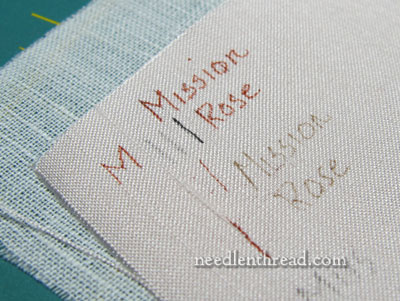
I cut the fabric to the size I would need – 14″ x 12″ which gives me at least 3″ all around.
While my fabric was still in the “raw” stage (just cut), I tested some pens and pencils on the corner, to get an idea of what transfer method I want to use. I really like the brown ink on the pink fabric, but it will require a very light hand to get a crisp line.
With the fabric cut, I betook myself to the Sewing Machine.
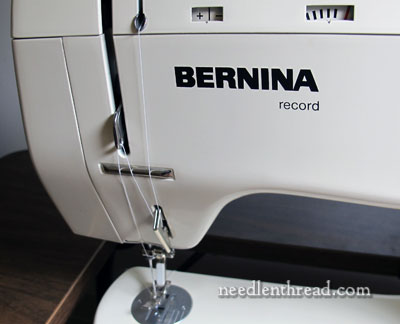
Now, I’m not a sewing machine person. I have this old workhorse of a Bernina that I bought used years ago, because it is a workhorse, and it can do what I need it to do.
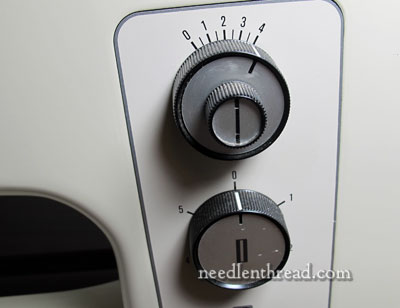
It doesn’t even have computerized controls.
I have a thing about sewing machines. I’m not really afraid of them – beyond thinking that a malfunctioning sewing machine will most likely play a role in my death – but I’m not really comfortable with them, either. So I don’t use a machine unless I really have to.
Working with this kind of silk, though, I strongly advise using a machine to oversew the edges! When silk fabric frays along the edges, it is slicky-sticky – it’s slippery and it sticks on absolutely everything, thanks to that wonder of nature called Static Cling. Static Cling and I go way back – I even wrote a poem dedicated to Static Cling once upon a time – and it is part and parcel of the life of silk fabric.
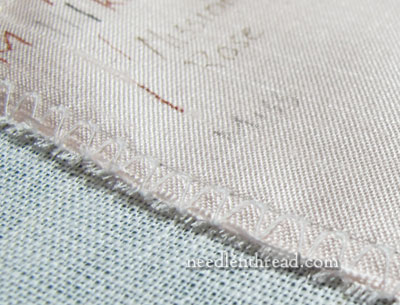
Though you can barely see it here because I used white thread, these edges are now oversewn (I used the overlock foot on my machine, because I think it holds edge threads in better) and will stay put. Ahhhh. Peace of mind!
You can also use a zig-zag setting on a machine, for similar results – just zig-zag along the inside edge of the fabric. And, if you don’t have a machine, you can whip stitch the edges by hand. But if you must work by hand when using silk, lay your silk flat on the table and don’t hold the whole piece of cloth in your hand while you whip stitch. Touch it as little as possible. Try to keep it as wrinkle free and hand-oil-free as possible.
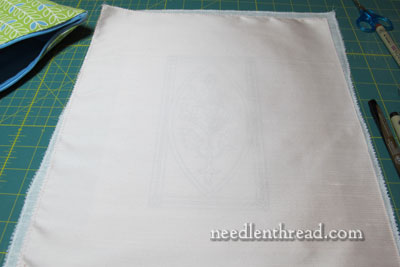
Both the pink silk and the linen are ready to go! Next tasks: deciding on the type of embroidery frame to use and deciding on the embroidery design transfer method.
In the photo, you can see just a hint of the rectangular frame of the embroidery pattern in the middle of the pink silk, because the printed design is underneath the fabric.
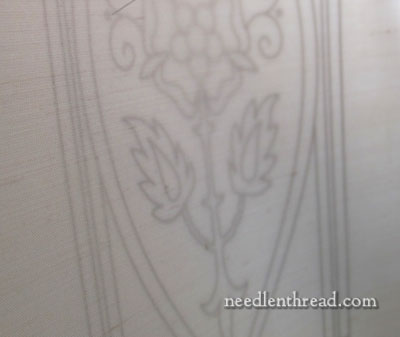
With the design and fabric held up to the light, you can see that the design involves straight lines forming an outside frame, so it’s likely that I will trace the design onto the fabric rather than prick and pounce it. It’s much easier to use a ruler for straight lines when tracing than it is when using the prick and pounce design transfer method.
Mission Rose is underway! Fingers crossed, it’ll come out as planned!
Any questions, comments, or suggestions? Feel free to leave them below!







Good Luck…I can’t wait to travel this journey with you.
Susan
What type of frame do you use for silk ?
Hi, Pat – I’ll use one of three choices: a slate frame, the Millenium Frame, or Evertite stretcher bars. The only thing that’s really not an option is a hoop, because it’s very difficult to get hoop marks out of silk. Well, the project will involve some goldwork, anyway, which doesn’t work too well with a hoop. For this project, I’m leaning towards either the stretcher bars or the Millenium frame. My smaller slate frame has a project on it already, and I don’t want to take it off! ~MC
G’day there Mary,
Wow, this is wonderful. I’m pleased it’s being embroidered on silk. I hardly know why, it just seems right. Greatly looking forward to following this.
Cheers, Kath.
What is the finished size of the flower, and then with the borders? Thanks.
The design size, in total, is 4″ x 7.5″…
Mary!!
I am over the moon with this group prihect!!! Particulary anything remotely Arts & Crafts.
I will be the participant asking a lot.of questions; my hand embroidery is rusty
My first question: where do you syggest I find the silks and backing fabric? I live inva small town with one ‘fabric ‘.
Could you point me to abln online shop? And please be very specific re: type of fabric to ask for. Akso, what size/type if of needle(s) ??
Ithink I thought of all for now. smiles. Am so excited
Thank you, Mary
Melanie
sorry for this silly question. my first time to site. where is the pattern/instructions for this pattern. i’d like to try my hand at it. tx.
I haven’t put the pattern up yet, so it’s not available just yet..,
I’m looking forward to following your progress on this.
As far as sewing machines – you have one *sweet* machine! Like you said, a workhorse, and no electronic boards to go haywire. If it ever needs a new home, let me know.
Mary,
If you put the design on the fabric before you mount the fabric to the frame, won’t the design warp when you stretch the fabric?
It depends on how you mount it and transfer it. If it is transferred on the grain, and the fabric is mounted perfectly square, it shouldn’t be a problem. I do it either way, depending on how I’m transferring and mounting the project. -MC
Although I’m not as averse to sewing machines as you, we do have this in common: YOU have a twin to one of my older work horse machines! A Bernina circa 1972 or so! I love it.
I love your column and delight knowing when I’m in a ‘hand’ work mode (mostly I’m a quilter) I can go back to your columns and find almost anything I need to know!
Enjoy “Rose”…….
Lynn
This! I work for a sewing machine dealer/repair service and I’ve learned that Bernina makes high quality machines. We see lots of 30 and 40 year old Berninas that work just fine. A mechanical machine is not inferior to a computerized one – just different!
Hi, Julie – definitely not inferior – I think the old machines are better made than the newer ones, personally. I needed a machine that would go through heavy duty stuff, and this one does it, like butter. I need to have it serviced…..!
Ah, Mary…you touched a nerve w/your comments on sewing machines. I have never, ever met one that didn’t immediately have a break-down in my presence. I remember once, picking up my little Singer from the shop where I had them adjust the tension because no matter what I did, it was always off. They stitched w/it in my presence and all was “sweetness and light”. I drove home and set it up and the tension was off. I did NOTHING, I swear. So I look at them w/trepidation, as well.
Hi Mary,
I love embroidering on silk, and can’t wait to see your work.
That Bernina is no old workhorse! I have one just the same, and have loved it for over 30 years – the stitch is unbeatable. It is a classic and people are ready to pay an awful lot of money for them, you know.
Hi, Val -you’re right! This is a good machine! By old workhorse, I mean it works hard, like a workhorse. That’s why I bought it. The old Berninas are the best machines, I think. All steel construction and parts – and it just keeps going and going and going. Love it!
Mary,
I’m so delighted with the new project,and will be following closely – anything gold and silk work to grow my own skills.
I do have to give a little chuckle about the sewing machine:) Sewing is and always will be my first love. I have 2 machines, and 2 sergers; fancy, computerized machine embroidery things. Funny, since discovering your site, the machine embroidery (and the machines) sits there untouched, as do all those beautiful threads that I’m staring at on those 2 racks! But, no regrets when moving on to hand embroidery.
I do love the use of my serger for finishing edges prior to starting embroidery. It’s clean, neat, and fast. But then – there are those cutting blades to contend with……
Best of luck with the new project!
Hi Mary, I love anything Arts and Crafts, so I’m going to enjoy following your project. Can’t wait to see what colors you select…are you thinking Arts and Crafts colors as well?
I’m so happy to see a new work in progress. As much as I enjoy your stitching tutorials and book reviews, I love watching you work on a piece from beginning to end. I’m hoping along the way you’ll share how you manage to keep the tension just right on silk to avoid all those ugly little puckers around the edge. Silk is so delicate and you can’t just press the heck out of it when you’re done. I’ll be following closely.
Mary,
I love watching your projects – the good days and even the rip-out days!
My embroidery is simple, and often self designed — so I’m always wondering about transferring onto the fabric. Tracing works so well but I struggle finding the right pen(s).
What is best? What do you use?
And thank you so much for all you share!!
Christie
Appleton, Wisconsin.
Hi Marymentor:
I’ll be following the early stages of this project with great interest. As for (1) “mounting” on to the frame prior to working, and (2) especially now, as I see this last photo …the transferring a pattern has always left me a bit worried. i.e. Will you be drawing the pattern directly on to the silk ? Silk is so soft and move-able. And as for the lighted pattern…..how many layers of fabric is that light shining through ? My concerns, I’m sure, will all be put to rest as we go through this process, so I’ll be watching closely. Thanks….Judy in Pittsburgh.
Oh Mary, you and I have the same “hesitation” when approaching our sewing machines. My mother bought us our first sewing machine when I was 12 and I had to muster all my strength of spirit to remain calm so I could convince her all would be well as I updated our kitchen curtains. It took machine sewing lessons many years later to truly gain real confidence.
And your project will be lovely. I’m just a little sad you haven’t kept the leaves around the frame area (as it was on the charcoal rubbing)as I love their drape and movement they conjured up.
Mary, thank you it is wonderful to watch your progressive work, to me the exciting part is the fabrics and thread choices you make, they always work so well.
As for the old workhorse, its the best machine going, hang on to it, I sold mine for a computerized one and am very sorry I did. Enjoy.
Haha! I was literally laughing at all the postings about sewing machines! They can be frustrating. I have taught many classes on using machines and just want to say that the sewing machine is to be thought of as a machine, and not a real reflection of a person’s sewing talent. They are two different things. Mastering a sewing machine is easiest if the owner practices threading it about a dozen times before using it. And learning how to untangle the bobbin, which is simply to cut or pull away the thread-y mess! And start again! Hope this helps people!
I like the idea of working with silk.
Since now, we can expect for tips on working with silk throughout the entire process.
Good luck on the mission
On the edge of my chair!
What a wonderful project! Thank you for sharing so generously.
You said today: “ground fabric choices made and the fabrics prepped,” Did you wash the fabric first? I tried to reread everything but I didn’t see that mentioned. After a few years, you make want to wash the piece, would it pucker if not prewashed?
Jackie
Hi, Jacqueline – The ground fabric is silk, which can be washed but washing changes the feel of it a bit, but there’s no need to wash it. This will not be washed years down the road – it’s going to be embroidered with silk and real metal threads, which can’t be treated like regular embroidery floss. So, washing is out! This means it’s necessary to take extra care while working the piece to keep it really clean, and I’ll be going over that point in the next article. ~MC
Thank you Mary 🙂
Hi Mary,
I want to work this project along with you, but I can’t seem to find the PDF for the pattern. Have you posted it yet? If so, can you guide me to it?
Many thanks! I’m excited!
Hi, Kathy – I haven’t posted the pattern yet, but I will soon. I just wanted to work a few kinks out first. But I suppose I could post the one I have, and then if I make changes, I can post the revisions. I’ll put it up later this week! ~MC
Won’t the roughness of the gold thread pull on the top fibers of the silk?
Hi, Arlene – No, not really. Goldwork is often (I’d almost say “usually”) done on silk grounds like this. Woven fabric like this is very “tight” – it doesn’t have stray or loose threads in the weave, so it will be fine. ~MC
This is a lovely design and will work up beautifully under your sure fingers Mary. I can’t wait to see it become ‘something’.
Please Mary, use the Millenium frame. Mine is all set up ready to go, but I am afraid to admit that I am not sure what to do next. Seeing what you do would be an enormous help.
Well, I already used the Evertites, I’m afraid! Sorry, Christina!
My short sides for my smaller rollers for the Millenium frame are being used on my larger rollers at the moment, for another project…. and my small slate frame has yet another project on it…. so, it was Evertites to the rescue! In fact, I prefer the Evertites for a project this size. They’re a lot lighter than the other choices, and more compact.
What are you stuck on, with your frame? Once it’s set up, you should be able to launch right in to the fun part – stitching! If I can answer any questions, though, let me know!
~MC
Dear Mary,
I am a new comer to your website and I would like to know what othe rmaterial could be used to do the rose pattern. Silk maynot be available. Please advise me on this.I want to buy it this weekend as I have to depend on my daughter-in-law’s schedule.
BTW let me tell you that i enjoy your work a lot and hope to restart embroidring! Thanks for the motivation.
regards
Mangala
Hello, Mangala – Thanks for your question. You can really use any fabric you have available, really. I like silk or linen for this kind of project because the threads I’m using are silk and gold threads, so a finer fabric is a little more desirable. But definitely use what’s available to you. For the type of stitching involved, if you’re going to work it the same way, you’ll want a ground fabric that has a high thread count – not a fabric with an open weave. Hope that helps! ~MC